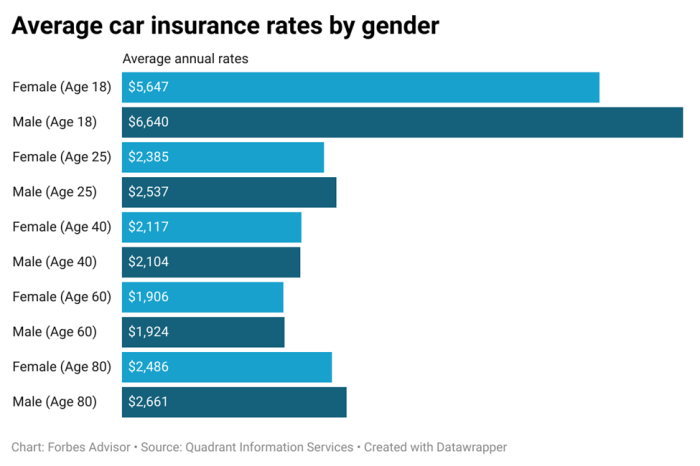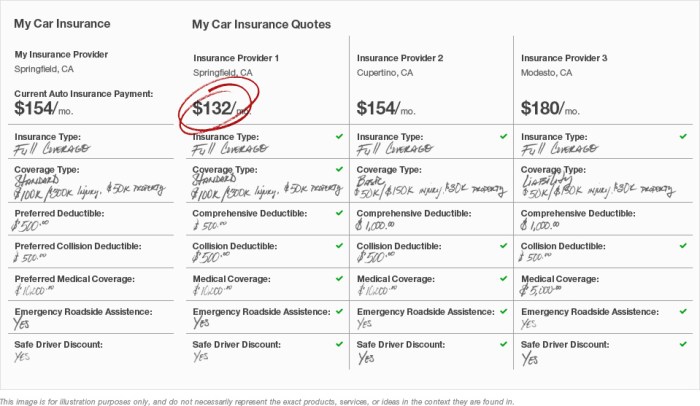Navigating the world of car insurance can feel like driving through a fog – premiums vary wildly, coverage options seem endless, and finding the best deal feels like a full-time job. This guide cuts through the confusion, offering a clear and concise comparison of car insurance costs, helping you understand the factors that influence your premiums and empowering you to make informed decisions to secure the best possible coverage at the most competitive price.
We’ll explore the key elements affecting your car insurance costs, from your age and driving history to the type of vehicle you drive and where you live. We’ll compare quotes from different providers, highlighting their strengths and weaknesses, and delve into the intricacies of policy details and coverage options. Finally, we’ll equip you with practical strategies to lower your premiums and save money over the long term.
Factors Influencing Car Insurance Costs

Several key factors contribute to the final cost of your car insurance premium. Understanding these factors can help you make informed decisions to potentially lower your costs. This section will explore the major elements that insurance companies consider when determining your rates.
Age and Driving History
Your age significantly impacts your insurance premium. Younger drivers, particularly those under 25, generally pay higher premiums due to statistically higher accident rates within this demographic. Insurance companies perceive them as higher risk. Conversely, drivers with a longer, clean driving record benefit from lower premiums, reflecting their reduced risk profile. Years without accidents, tickets, or claims demonstrate responsible driving behavior, leading to significant savings over time. For example, a 20-year-old with a clean driving record might pay significantly more than a 50-year-old with 20 years of accident-free driving.
Vehicle Type and Features
The type of vehicle you drive plays a crucial role in determining your insurance costs. Luxury cars, sports cars, and high-performance vehicles are typically more expensive to insure due to their higher repair costs and greater potential for theft. Conversely, smaller, more economical vehicles often command lower premiums. Furthermore, safety features such as anti-lock brakes (ABS), airbags, and electronic stability control (ESC) can influence your rates. These features demonstrably reduce the severity of accidents and therefore lower the risk for the insurance company. A new, high-performance SUV will likely be much more expensive to insure than a used, smaller sedan with fewer advanced features.
Location and Driving Habits
Your location heavily influences your insurance premium. Areas with high crime rates, higher accident frequencies, or more frequent instances of theft will typically have higher insurance rates. Urban areas often have higher premiums than rural areas due to increased traffic density and risk. Your driving habits also matter. Factors such as annual mileage, commuting distance, and driving record all play a part. Someone who commutes a long distance daily faces a higher risk of an accident than someone who primarily drives short distances. A driver with a history of speeding tickets or at-fault accidents will inevitably pay more.
Coverage Options
Different coverage options significantly impact the total cost of your insurance. Liability coverage is typically the most basic and least expensive, covering damages to others in an accident you cause. Collision coverage pays for repairs to your vehicle regardless of fault, while comprehensive coverage extends to damage from non-collision events like theft or weather damage. Adding these options increases your premium, but provides greater financial protection. Dropping collision or comprehensive coverage on older vehicles can significantly lower premiums, but it also leaves you financially responsible for repairs in those scenarios.
Coverage Cost Comparison
| Coverage Level | Liability Only | Liability + Collision | Liability + Collision + Comprehensive |
|---|---|---|---|
| Monthly Premium (Example) | $50 | $80 | $100 |
Note: These are hypothetical examples; actual costs vary significantly based on individual circumstances.
Epilogue

Ultimately, securing affordable car insurance involves understanding the variables at play and actively engaging in the comparison process. By leveraging the insights provided in this guide, you can confidently navigate the complexities of car insurance, compare quotes effectively, and secure a policy that offers comprehensive protection without breaking the bank. Remember, a little research and planning can go a long way in finding the perfect balance between cost and coverage.
Q&A
What is the difference between liability and collision coverage?
Liability coverage pays for damages you cause to others’ property or injuries you inflict on others in an accident. Collision coverage pays for repairs to your vehicle regardless of fault.
How often should I compare car insurance quotes?
It’s recommended to compare quotes annually, or even more frequently if you experience significant life changes (new car, moving, etc.).
Can I get car insurance without a driving history?
Yes, but it will likely be more expensive. Insurers may use other factors to assess risk, and you might be considered a higher-risk driver.
What is an SR-22 form?
An SR-22 is a certificate of insurance proving you maintain the minimum liability coverage required by your state after a serious driving offense.